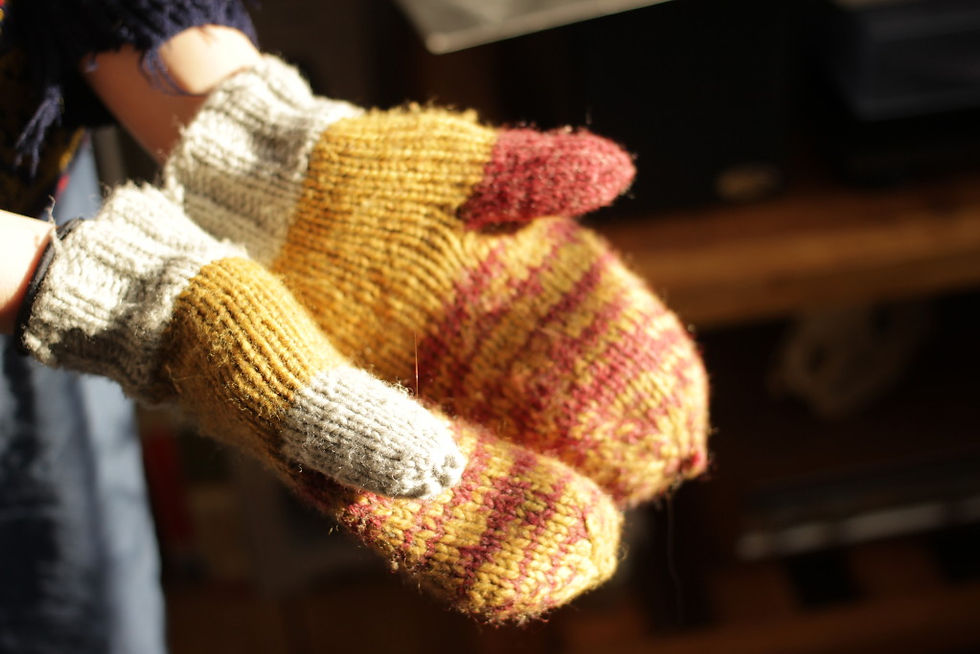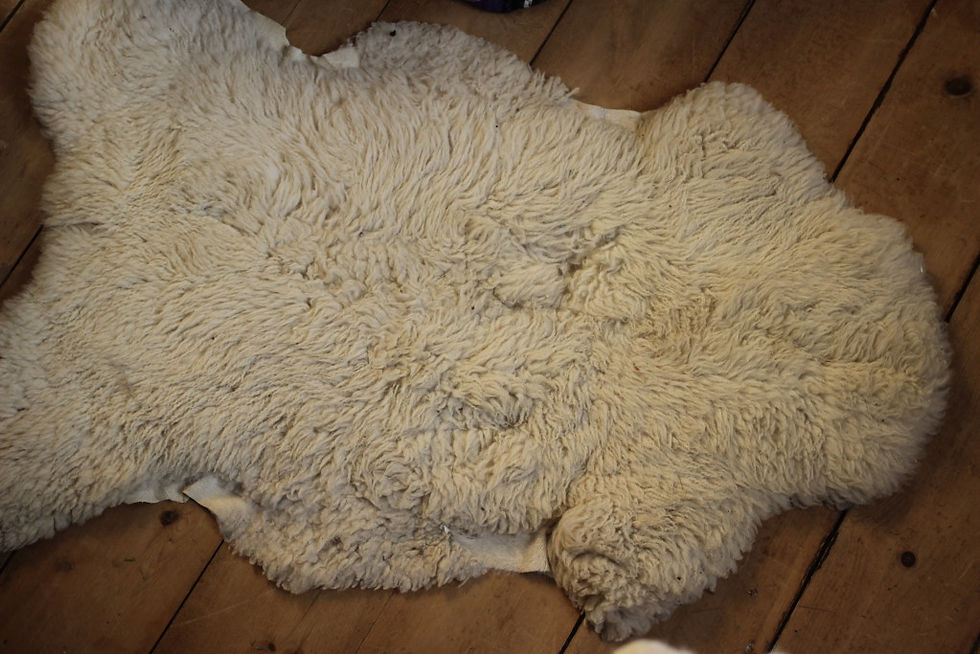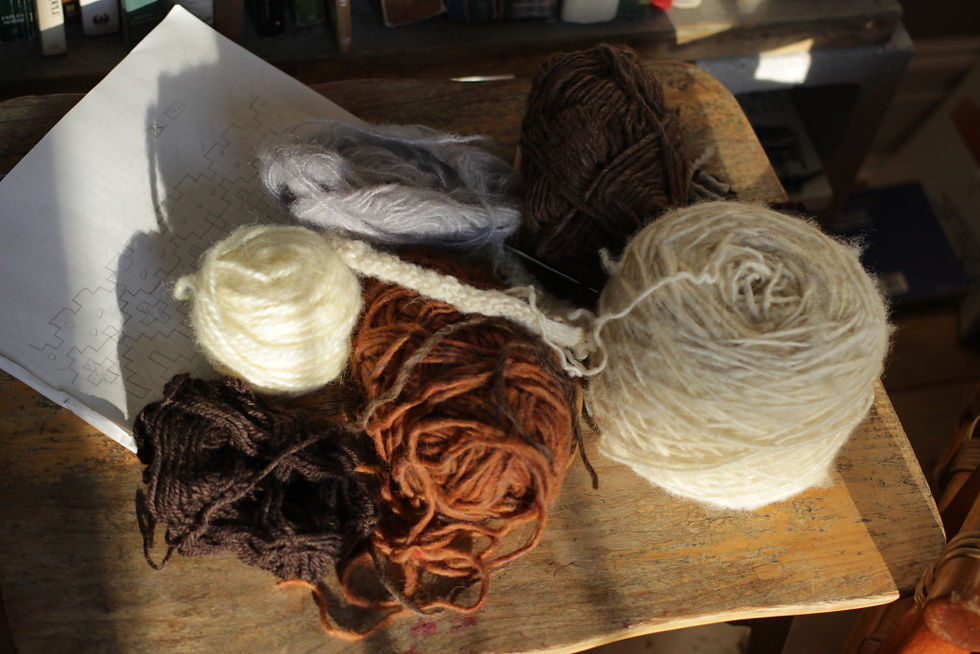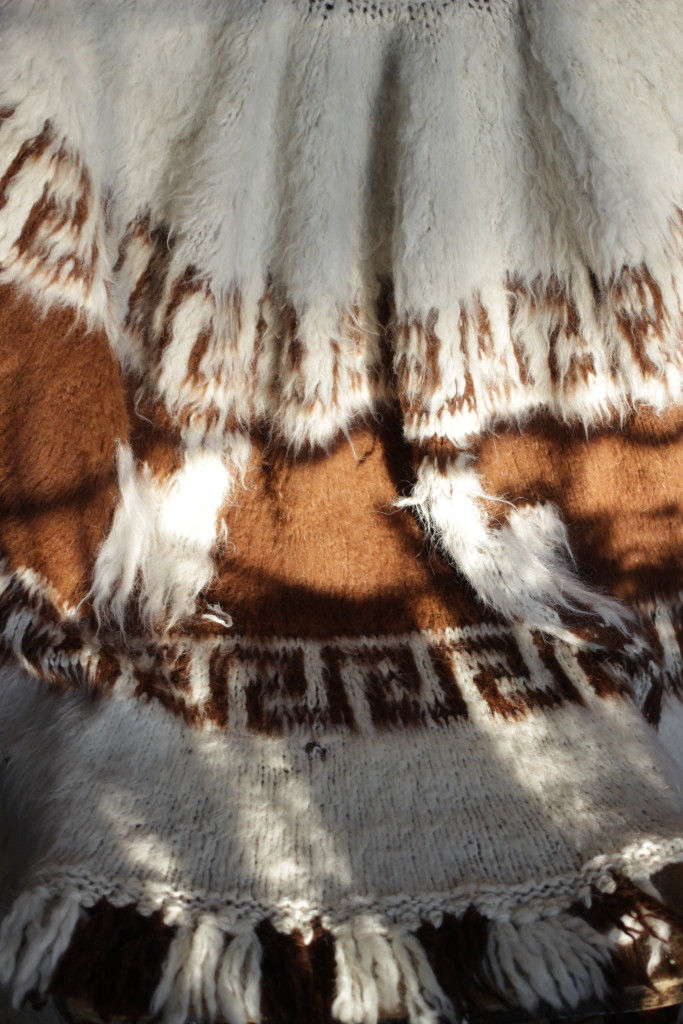Woollen Rovings
- Humanimalab

- 23 janv. 2016
- 6 min de lecture
The first of a few thoughts on the woollen. I offer this article as my first general and humble ‘Baaaa’ on the matter.

Have you ever smelt your woollen mittens all wet after a winter’s frolic? Mine smell like I’ve stepped inside a barn, wonderful whiffs of sheep in a bed of hay. Wool is so very much a product of human animal relations, being the result of centuries of human-animal co-evolution and the knowledge and craftsmanship that naturally weaved itself with time. Notwithstanding, if I am to write about wool within the corpus of human animal relations, I feel impelled to begin by casting on justifications: for example, in case it might have slipped some minds, wool is the fibre of sheep, alpacas, angoras and so on, and may include, depending on one’s leanings, a wider range of mammal furs and hairs (although if you ask some, wool should only designate sheep fibre). Perhaps this need I feel to re-root wool to the animals on which it grew comes from the realization that our contemporary life is saturated with a plethora of objects, the paths of which are mostly unwritten. As for the fibres that surround us, cloth us and drape our world, many of these are now synthetic, and perhaps it is not bending the truth too far to assume that whatever woollen garments we do own are not necessarily evocative of the sheep from which they came. Synthetics aside, our world is made up of an array of animal (and plant) by-products with which we entertain some relations, although often the relations we have with the animals (or plants) in question are mostly, if only, ideological. What kinds of relations do we have with animals, in regards to the animal by-products we encounter? Do we nurture relationships with the life forms, the animals, the plants, from which our belongings, our foods, our surroundings are made? If so, what kinds of relations are they? I find these great questions to begin with.

For the most part, and pardon the generalization, we are so far removed from modern day centres of production, that the provenance of the world of objects is often unknown, to say nothing about the processes of their manufacture. Although it is becoming more and more commonplace to, say, lament the plight of those who can barely trace food’s path beyond the grocery store, I surmise that in so doing we are foregoing, in some kind of hypocritical fashion, our own short-sighted nature. In an age when there are millions of different objects to purchase, wherein these objects can be purchased ready-made, we naturally become distanced from the processes of their production. Yet, concomitantly, we are well into an age, ranging from newborns to wise sages, of environmental thinking. For many, the wheel of environmental thinking is a constant, for some pestering, for some welcomed and grounding, whirl, spinning, or should I say weaving a complex tapestry of thoughts on the matter. The product of these reflections is manifold: environmental consumerism, economical vote, ecological living, locavore movements, seasonal consumerism, etc. etc. etc. These are categories that serve to nominally represent recognizable social movements and philosophies that have come into being, not out of thin air, but because of a matrix of social factors. For example, what’s at stake in buying eggs nowadays? Well, to buy eggs from a neighbour who grows his or her own feed for the chickens, and produces enough for a family and friends, might not evoke the same concerns as to buy eggs from an enterprise that mass produces them, and that in turn buys feed that might be genetically modified, have been grown in monocultures, or be pesticide laden, and which is fed to chickens that live their entire lives inside a chicken size metallic cage in a factory lit up by light bulbs meant to mimic the sun… Somehow evocative of Plato’s cave, the latter situation might inspire a need to start thinking about things like animal ethics, environmental ethics, morals about production and our values about life on a broader scale. Furthermore, the latter situation as represented herein is, more often than not, an attenuated and less horrifying account of contemporary industrial egg production. True, for some people, this account is not in the least troublesome, and in fact, for these people, it is often lauded as a feat of agribusiness, economy and technology. Nonetheless it remains that for others, the knowledge of these means of production is an increasingly difficult reality to swallow, becoming ever-the-more-so impossible. Our world is filled with objects, much beyond the realm of food, that are produced in like fashion, and awareness is affecting consumer ethos. For example synthetic fibres make up the greater part of the fabrics that are sold industrially, though we are not (yet) in the fashion of asking ourselves: What is this fabric made of? How is it produced? What are synthetic fibres, where do they come from, and how are they made? Nylon, for example, aka aliphatic or semi-aromatic polyamides, was first manufactured in DuPont’s research facility; the same company that invented the ozone hungry CFCs.

I find there is good food for thought here in Heidegger’s distinction of the thing and the object, wherein a Thing could be a hand-made jug, and an Object would be a factory made Coke bottle. As Latour (2004) explains: “While the latter is abandoned to the empty mastery of science and technology, only the former, cradled in the respectful idiom of art, craftmanship and poetry, could deploy and gather it’s rich set of connections.” From thereon, it seems to me an interesting practice to look around and ask oneself: what to me is a thing, and what is an object? On this matter, although without allusion to Heidegger’s thing and object, William Coperthwaite dedicated most his life. His philosophy is one of simplicity, utility, and craftsmanship, quoting for example Peter Denko’s “the chair is the decoration (quoted in Coperthwaite 2007:24)” to at once elevate the artfulness and craftsmanship in a well made chair, whilst at the same time extoling the beauty’s inherent in a simple life made up of meaningful items. A Thing, in Heidegger’s conception of it, is made up of the connections inherent in the processes of making, just like a hand-knit mitten is, in Coperthwaite’s mind, imbued with the concern and intention for which it has been knit (Coperthwaite 2007:23). The distinctions, I believe, must depend on the matters of concern. For example, if we set wool to the contrast of synthetic fibres, we might be tempted to generalize the former as ‘a thing’ compared to the latter as ‘an object’, whilst on another level, we might be temped to distinguish wools that are produced sustainably as things, from those that are produced industrially as objects. It can be argued that these distinctions vary according to a person’s values. What seems implied herein though, in the distinction of a thing to the object, is that the former tells the story of life, it’s making having been tangled up in a relationship between it and the maker, wherein the object, when taken back to it’s origins, is revealed ‘a clone’, a manufactured machine reproduction. Although the machines might require human activation, the process of manufacture requires no attuned relationship between the human and the ‘object’, no mastery safe perhaps a mastery of machines, ‘science and technology’. Here, it is interesting to ask: what of machines? Could the coffee machine perhaps be considered the artful conception and product of concern? Does this lead us back to that age-old debate about the quality of the ‘original’ in its relation to the reproductions? Can an object have some degree of thingness?

Set to the contrast of synthetic fibres chemically produced through highly volatile means in big factories, I wonder about the quality of wool in relation to the animal’s life, which is in itself dependent on a complex ecology: natural, geographical, and ideological (farming ideologies for example). Wool, in comparison to synthetic fibres, is an animal product, and thus, I find it a matter of fact that to write of wool without invoking animals is to leave much of the story out of the picture. On this, Wovember’s thoughts are marked. Wovember (http://wovember.com/) is a group dedicated to wool awareness, who’s motto is “real wool comes from real sheep.” In their appreciation for the qualities of wool, they seek to counter consumer ignorance sowed by the fashion industry who profit from the wool industry by “describing garments and fabrics as wool that contain little or no wool at all.” As they write: “By reconnecting the words woolly, woollen and wool with the noble animal from which that peerless fibre comes, it is hoped that we will be able to end … their misapplication to garments which bear no connection to actual sheep.”
From matters of soil and fleece quality, invoking the relations between wool, soil health and agricultural practices, to philosophies about animal fibres, to the global wool market and discourses on craftsmanship and production in regards to its processing and farming… I find wool a rich and diverse subject on which to pause and ponder human animal relations.
Sources
Coperthwaite, William. 2007. A Handmade Life – In Search of Simplicity. Vermont: Chelsea Green Publishing.
Latour, Bruno. 2004. “Why has critique run out of steam?” Critical Inquiry 30(2): 225-248.
Wovember: http://wovember.com/






Commentaires